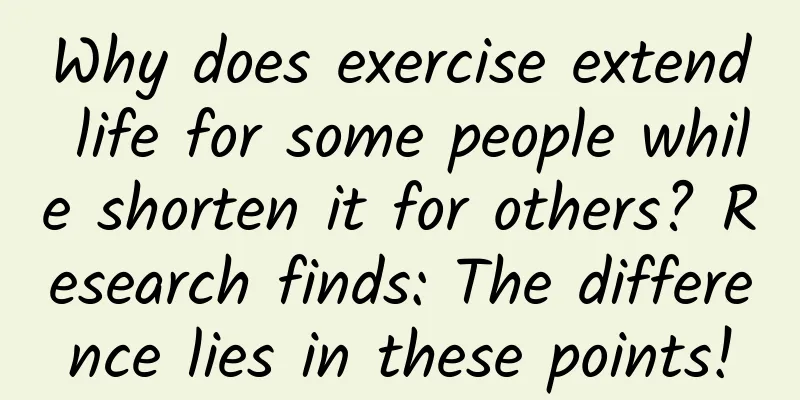Why does exercise extend life for some people while shorten it for others? Research finds: The difference lies in these points!

|
As the saying goes, "Life lies in exercise." But have you ever noticed that "exercise does not equal longevity." In life, some people who never exercise are in poor health and have a hard time living long. However, some people who love sports very much or are fanatical sports enthusiasts do not live long. This is not a coincidence. As the saying goes, everything has a "degree" , and the same is true for exercise. Studies have found that there is a U-shaped correlation between exercise and health, and exercising for more than this time will have fewer benefits! Photo by Jin Peng Why does exercise extend some people’s lifespan while others shorten it? A study on exercise and health was published in the medical journal Mayo Clinic Proceedings in 2021. The study recorded the exercise and health data of 8,697 adults for more than 20 years and found a special U-shaped connection between "exercise and health." The study found that: 1. People who exercise 2.6 to 4.5 hours a week have the lowest risk of death, which is about 40% lower than those who do not exercise. 2. People who exercise more than 10 hours a week have an increased risk of death and a lower sense of happiness compared to those who exercise 2.6 to 4.5 hours a week. Exercising 2.6 to 4.5 hours per week is equivalent to exercising for about 30 minutes a day. The results of the study show that after reaching this critical point, continuing to increase exercise time does not bring more benefits, and may even be counterproductive. This also explains why many avid sports enthusiasts are not as healthy and live longer than those who exercise less than them. The researchers said, "This finding surprised them. They have always thought that the more exercise you do, the better it is for your health, but they didn't expect there would be a critical point." Why is excessive exercise bad for health? Researchers explain that long-term intense exercise may put the body in a state of "excessive tension". In the long run, the immune system function will decline, the recovery ability will be weakened, and the risk of disease will increase. Health Times There is also an optimal time for exercise In February 2023, a study published in the journal Nature Communications by Zhang Jihui's team from the Affiliated Brain Hospital of Guangzhou Medical University showed that moderate to vigorous physical activity at any time of the day can reduce the risk of death from all causes, cardiovascular disease, and cancer. But more importantly, compared with other time periods, exercising between 11:00 and 17:00 every day can further reduce all-cause mortality and cardiovascular disease mortality. The study analyzed more than 90,000 people and found that compared with exercising in the morning (5:00-11:00) and evening (17:00-24:00), exercising between 11:00 and 17:00 every day reduced all-cause mortality by 11% and cardiovascular disease mortality by 28%. It can be said that this is the most ideal time for exercise. The three most effective types of exercise for prolonging life In addition to the "best exercise duration" and "best exercise time period" , there is also the "most cost-effective exercise". With the same exercise time and the same exercise intensity, some exercises can more effectively reduce the risk of death, bring health benefits and prolong life. In 2018, The Lancet medical journal published a 15-year sports health survey report involving 80,000 people, which listed the "three types of exercise with the best life-extending effects." No. 3: Indoor aerobics Reduce all-cause mortality by 27% Common sports: aerobics, yoga, dance, etc. Indoor aerobic exercise can exercise your cardiopulmonary function, improve your vascular function, and lose weight. It can also help improve high blood pressure, high blood sugar, and high blood lipids. It can reduce the risk of cardiovascular disease by about 36%. If you can achieve the recommended amount of exercise, you can reduce the all-cause mortality rate by about 27%. 2. Swimming Reduce all-cause mortality by 28% Common sports: breaststroke, backstroke, freestyle, etc. While exercising muscles throughout the body, swimming can help improve blood circulation and enhance cardiopulmonary function, prevent cardiovascular diseases such as arteriosclerosis in the elderly, slow down the decline of respiratory function, and reduce the risk of cardiovascular disease by about 41%. If the recommended amount of exercise is achieved, the all-cause mortality rate can be reduced by about 28%. In addition, swimming puts less pressure on spinal joints and knee joints, making them less prone to injury. No. 1: Racquet Sports Reduce all-cause mortality by 47% Common sports: table tennis, badminton, tennis, etc. Racket sports often require the mobilization of multiple muscle groups in the body, and the coordination of the hands and eyes by looking at the ball. At the same time, there will be a relative burst of power at the moment of hitting the ball. It emphasizes coordination, flexibility, and a certain degree of endurance, which can help us improve muscle and bone strength, cardiopulmonary function and coordination, and can make people more focused, keep the brain active, and help delay brain aging and protect the cardiovascular system. Compared with people who do not exercise, people who participate in racket sports can reduce the risk of cardiovascular disease by about 56%. If they can reach the recommended amount of exercise, they can reduce the all-cause mortality rate by about 47%. References [1]Schnohr P, O'Keefe JH, Lavie CJ, Holtermann A, Lange P, Jensen GB, Marott JL. U-Shaped Association Between Duration of Sports Activities and Mortality: Copenhagen City Heart Study. Mayo Clin Proc. 2021 Aug 17:S0025-6196(21)00475-4. doi: 10.1016/j.mayocp.2021.05.028. Planning and production Source: Health Times (jksb2013) Reviewer: Tang Qin, Director and Researcher of the Science Popularization Department of the Chinese Medical Association Editor: He Tong Proofreading丨He Tong |
>>: I always feel that men are greasy, but why are men's faces more oily?
Recommend
Why can't we feed rabbits water? Why can't we feed rabbits grass with water?
Rabbits usually have long ears and are very cute ...
Breaking through the fog and revealing the six major misunderstandings about smoking and quitting smoking
In today's society, the relationship between ...
Is it okay for babies to wear other people's old clothes? What kind of old clothes can't babies wear?
We all know that when a baby is just born, many m...
Perineum anatomy
Perineal laceration refers to the situation durin...
What causes uterine congestion?
Every woman has a dream of becoming a mother, so ...
How long is the best time to close the abdomen after cesarean section
Mothers who give birth by cesarean section will n...
TBG Digital: The average CPM of Facebook in Q4 2011 was 22 cents, an increase of 8% from the previous quarter
On January 17, 2012, TBG Digital, an independent ...
What are the causes of joint pain after childbirth?
For women, childbirth is a particularly important...
What are the symptoms of pregnancy and childbirth?
Many women want to know the gender of the fetus d...
It is rumored online that a Japanese restaurant changed its statement and said that the selected fish species is rainbow trout. Is rainbow trout really salmon?
The new coronavirus was detected on the cutting b...
What causes dysmenorrhea in women?
Dysmenorrhea is the most painful thing for girls....
Stinky duck egg smell with bloody vaginal discharge
Women will have leucorrhea about fourteen days af...
How much does pelvic correction cost?
The pelvis is one of the most important structure...
What causes yellowing of garlic seedlings? What to do if yellowing occurs in garlic seedlings?
Why does garlic turn yellow for no apparent reaso...
What causes thick and yellow discharge?
Under normal circumstances, women's leucorrhe...









